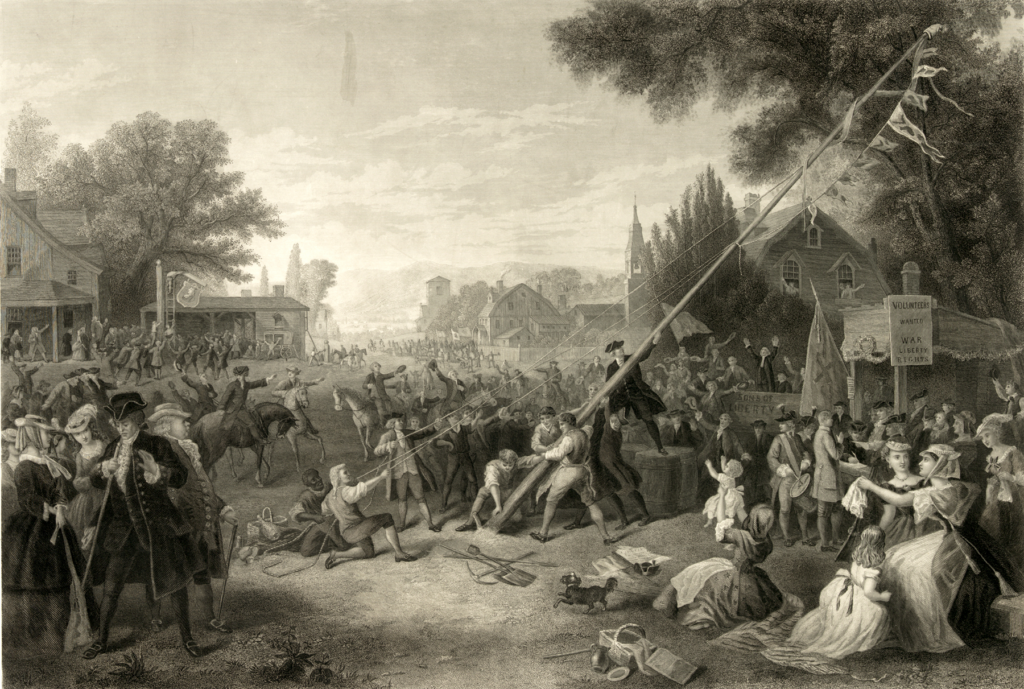How it all began… Part 5
The Battle of Golden Hill as depicted in a 19th Century etching.
As George Grenville’s ministry came to an end with the repeal of the hated “Stamp Act”, William Pitt (Lord Chatham) was called to form a new ministry. One of the people he brought to his ministry was the English dandy, Charles Townshend who became the Chancellor of the Exchequer (the British Treasury department).
Townshend claimed to have a plan that would create an income stream the colonies would accept and soften the tax burden that rested on the landed gentry of England. This sounded good to the heavily taxed squires but Townshend did not readily produce his plan driving the squires to believe Townshend could not actually give them the tax relief they were expecting.

When “Champagne Charley” did produce his plan, it called for Parliament to place taxes on glass, paint, paper and tea and gave colonial courts the right to issue “Writs of Assistance” to customs officers to search for contraband and smuggled goods on private property.
Beginning in 1767 Townshend unveiled his long awaited plan that included 4 separate parts, “The Revenue Act of 1767, the Commissioners of Customs Act of 1767, the Indemnity Act of 1767, the New York Restraining Act of 1767, and the Admiralty Court Act of 1768”.
The purpose of the 4 acts were,
- To raise a revenue in the colonies to pay colonial governors and judges so they would remain loyal to Great Britain;
- Enforce compliance with trade regulations;
- Punish New York for not enforcing the Quartering Act of 1765;
- Maintain Parliament’s right to tax the colonies.
Before the Townshend Duties as they were known could be fully initiated, Townshend unexpectedly died at age 42 in September of 1767. Repeal of the Townshend Acts officially occurred on April 12, 1770 with the exception that the tax on tea was continued.
“The Revenue Act of 1767” included language for the removal of the “power of the purse” from the colonial legislatures, giving the revenue raised by the act to pay colonial governors and judges for fealty to the British Crown. This deprived the colonials of any kind of leverage or control over the governors and judges in the colonies.
The “Quartering Act of 1765” set the stage for the suspension of the New York Legislature. This act further inflamed the colonials thereby driving even more acts of overt civil disobedience. Rather than direct conflict, the New York assembly simply voted to allocate 1,500 pounds for the British troops by way of a grant, making it appear as a free gift rather than compliance with the Quartering Act. This was a stealthy act of civil disobedience that the English Parliament accepted as compliance to the act instead of retaliating against the colony of New York which would have only exacerbated an already overheated situation.

The “Battle of Golden Hill” on January 19, 1770 would mark the first skirmish between British Troops and American patriots as British troops tried to post handbills in a New York Market. Some sources claimed that an American died but was never confirmed, but it is the first clash between Americans and members of the British Army in what would eventually be “The American Revolution”.
Colonial newspapers were very effective in rousing the rural population to support the “Non-Importation Act”, a pact the colonial assemblies were able to enact in August of 1768 that restricted the import of finished English goods into the colonies. The plight of Ireland and the resulting level of poverty that Parliament’s actions caused the Irish commoner were all the rural Americans needed for them to see the results of British domination. The continuing threat of British troops to enforce colonial acceptance of Parliamentary rule was a deciding factor for many American farmers to support the Non-Importation Act
The arrival of four regiments of British troops in Boston in October of 1768 only reinforced the fear of troop intervention for the purpose of colonial taxation. The lack of total support for the acts of Parliament by its own members did little for the merchants of England, but the removal of two regiments from Boston in 1769 to Halifax gave the farmers the courage to no longer strongly support the Non-Importation Act and by August of 1770, died from lack of rural support.
By this policy of enacting and then rescinding acts of force the British Parliament undermined its own authority in the colonies. The forces that remained in Boston were too few to truly keep order. Numerous scuffles and other acts of civil disobedience and defiance by Boston civilians continued; the inevitable happened on the evening of March 5, 1770 as British troops fired on American patriots killing 5 and wounding 6 others in what would be called “The Boston Massacre”.
In a strange twist of affairs, John Adams, who would be the Second President of the United States defended some of the British soldiers and their commanding officer in the aftermath of the “Boston Massacre”.
Authors note: American patriots were called Whigs and Revolutionaries while the supporters of the Crown were called Tories and Loyalists.
